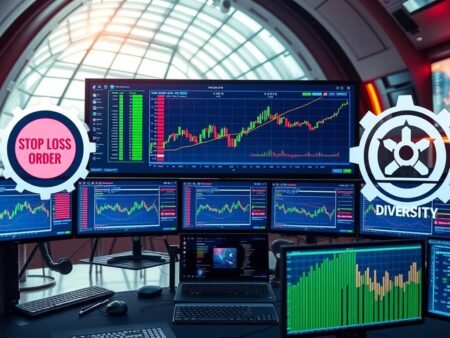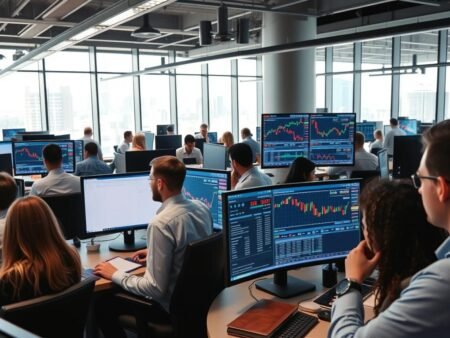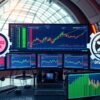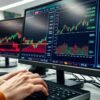Have you ever wondered how Prop Firms Use Simulated vs Real Accounts in Evaluations to find the next trading stars? In the world of proprietary trading, picking the right people is key. Aspiring traders face tough tests to show their skills, but the setting matters a lot.
Choosing between simulated and real accounts can make a big difference. It’s all about understanding risk, strategy, and market psychology. Prop trading firms use both types to find traders who can handle the financial markets’ ups and downs.
This raises a big question: Does the evaluation environment change a trader’s success, or does it show their true skills? This is not just a theory; it’s very important for both prop trading firms and the traders they want to hire.
We will look into the evaluation process in detail. We’ll cover performance metrics, better trading evaluation methods, and risk management techniques used by top firms.
Key Takeaways
- Insight into the evaluation techniques used by prop trading firms.
- Understanding the differences between simulated and real trading environments.
- Exploration of performance metrics critical in trading evaluations.
- Impact of the evaluation environment on risk management strategies.
- Preparing traders for the transition from simulated to real-world trading conditions.
Understanding Proprietary Trading Firms
Proprietary trading firms are key players in the finance world. They use financial simulation and strict prop trading evaluation criteria to boost their success. These firms manage their own money and reward top performers. This helps keep markets liquid and prices fair.
The Role of Prop Trading in the Finance Industry
These firms are more than just market players. They are the heartbeat of market changes. With advanced simulations, they spot and act on market shifts quicker than others. This helps their trading and makes the markets more stable.
How Prop Trading Firms Operate and Make a Profit
Making money in prop trading depends on tech and talent. They earn from day trading, arbitrage, and swing trading. These activities are improved by detailed simulations and strict evaluation criteria. The model splits profits with traders, motivating everyone to do better.
In summary, these firms offer a chance for skilled traders to grow. They use the latest tools and strict criteria to stay profitable and manage risks well.
| Aspect | Role in Prop Trading | Impact on Revenue |
|---|---|---|
| Financial Simulation | Enhance trading strategies and predict market changes | Increases potential trading opportunities and profitability |
| Evaluation Criteria | Standardizes trader performance assessment | Aligns trader goals with firm profitability, reducing risk |
| Market Impact | Fills market demand-supply gaps | Stabilizes firm’s revenue streams and enhances market presence |
By staying ahead in the trading world, these firms grow and help the financial market too.
Distinguishing Simulated vs Real Trading Accounts
It’s important for traders to know the difference between simulated trading accounts and real trading accounts. Simulated accounts are safe but don’t feel like real trading. They don’t have the same stress and market flow as real accounts. This section explains how these differences affect trading.
Market Liquidity and Trading Execution: Real trading accounts face real market changes. These changes can affect how trades are made and prices are set. On the other hand, simulated trading accounts use models that don’t fully capture these changes. This means traders miss out on real experience.
Psychological Impact: Trading with real money is stressful. The fear of losing money greatly influences how traders make decisions. This stress is not felt in simulated trading.
| Feature | Simulated Trading Accounts | Real Trading Accounts |
|---|---|---|
| Financial Risk | No real money involved | Real financial exposure |
| Market Conditions | Often simplified and not reflective of real-time intricacies | Includes real-time market volatility and complexities |
| Psychological Pressure | Minimal due to lack of real-world consequences | High, with real money and consequences at stake |
| Strategy Testing | Allows for extensive testing without financial loss | Tests strategies under actual market conditions with real outcomes |
Switching from simulated trading accounts to real trading accounts is a big step. Traders need to get used to the real world of trading. This includes the psychological and financial aspects that really matter in real trading.
How Prop Firms Use Simulated vs Real Accounts in Evaluations
Proprietary trading firms use both simulated and real accounts to check trading skills and risk management. These checks are key to see if a trader can grow and handle money well in different market situations.
Comparative Assessment of Trading Skills
Simulated and real accounts show different views of a trader’s abilities. Simulated accounts let traders try strategies without losing money. This is great for learning and testing ideas.
Real accounts, however, add the stress of real money. They show how well traders handle real-world trading and risk.
Impact on Trading Strategies and Decision Making
Trading strategies change when moving from simulated to real accounts. In simulations, traders might take more risks because there’s no real loss. This can make them overconfident or misjudge their risk skills.
When they start trading with real money, the fear of losing can make them more cautious. This affects how they make decisions and perform in trading.
By using both types of accounts, prop firms get a full picture of a trader’s growth. This helps in making sure traders are ready for the real market’s ups and downs. It’s a way to ensure they can manage risks well.
Overview of Trading Evaluation Methods
Proprietary trading firms use many trading evaluation methods to check if traders are good. They look at how well traders do, their behavior, and how they handle strategies. This way, they pick the best traders to handle big money.
Performance metrics are key in this process. They measure how well traders make money and handle risks. They also check how traders analyze markets and adapt to changes. This gives a full picture of a trader’s skills.
Psychological tests are also important. They see how traders act under pressure and how much risk they take. Knowing this helps predict how well they’ll do in trading.
| Evaluation Method | Focus Area | Description |
|---|---|---|
| Performance Metrics | Profitability and Risk Management | Assesses quantitative ability to generate profit while managing risks. |
| Psychological Assessments | Trader Behavior | Evaluates emotional and psychological readiness under market pressures. |
| Strategy Evaluation | Adaptability and Skill | Tests the robustness and flexibility of trading strategies in dynamic markets. |
Testing trading strategies is also key. Firms watch how traders do in real or simulated markets. This shows if they can really use their strategies well.
By using all these methods, firms can really see if traders are good. They make sure traders fit with the market and the firm’s goals. This helps the business grow and keeps trading disciplined.
Advantages of Simulated Trading Accounts for Evaluation
Proprietary trading firms look for ways to check out potential talent without losing money. They use simulated trading accounts for this. These platforms mimic real market conditions, letting traders practice and improve their skills without risk. This section looks at the big pluses of simulated accounts, especially for managing risk in prop trading.
Cost-Effectiveness in Trader Development
Teaching traders can cost a lot, especially when real money is involved. Simulated trading accounts cut down on these costs. They offer a place for both new and seasoned traders to get better at trading. This way, they can learn faster and take more risks without losing money.
To learn more about this benefit, check out this detailed analysis.
Risk-Free Environment to Test Strategies
Simulated trading accounts also let traders test and improve their strategies without fear of losing money. This is key for risk management in prop trading. It’s a safe space for traders to try out new ideas and build confidence for real trading.
In short, simulated trading accounts are a big help for prop trading firms. They help in training skilled traders at a lower cost and with better risk management in a safe place.
The Realities of Trading with Real Accounts
Trading with real accounts brings unique challenges and responsibilities. These are different from those in simulated environments. The trading performance assessment in real settings tests a trader’s mental strength and ability to adapt strategies. Proprietary trading firms use these real-world experiences to improve their evaluation methods.
Every decision in real trading accounts has big consequences. It affects both your finances and your emotional state. Unlike fake accounts, real trading comes with real financial risks and strict rules. These factors are key in seeing if a trader can handle real stakes well.
- Psychological Pressure: Real account trading puts a lot of stress on traders, which can impact their decisions.
- Financial Risk: The real risk of losing money can change how traders manage risks.
- Regulatory Compliance: Following trading rules and standards is a must, shaping how traders act and practice.
These elements are part of a detailed trading performance assessment by prop firms. By understanding how traders deal with these challenges, firms can find candidates who can succeed and help achieve their financial goals in real trading conditions.
Importance of Risk Management in Prop Trading Evaluations
Understanding how traders handle uncertainty and risk is key for proprietary firms. Mastering risk management in prop trading is not just about cutting losses. It’s also about making the most of gains, which is a big part of trading evaluation methods.
Evaluating Risk Management Skills in Different Environments
In simulated settings, risk seems less real. But in real trading, the risks are very real. This change requires a flexible risk management plan. Firms check how well traders adjust these plans in different situations to see if they’re ready for real trading.
Psychological Aspects of Risk in Simulated vs Real Trading
The way traders feel about risk changes a lot between simulated and real trading. With real money, traders feel more responsible and make different risk choices. This part of trading psychology is very important during evaluations, making sure traders can handle the pressure of real trading.
To show the difference, here’s a comparison:
| Aspect | Simulated Trading | Real Account Trading |
|---|---|---|
| Risk Perception | Lower perceived risk | Higher perceived risk |
| Emotional Response | Less emotional attachment | Higher emotional engagement |
| Strategy Adaptation | More experimental approaches | Conservative and planned strategies |
In short, risk management in prop trading is crucial for trading skills and is a big part of trading evaluation methods. It makes sure the firm’s money is with people who can trade well and protect assets under different market conditions.
Criteria Prop Trading Firms Consider During Evaluations
In the world of proprietary trading, firms use strict criteria to check potential traders. They look at both simulated and real trading accounts. This helps them see how well a trader can handle real market conditions.
This method makes the screening process better. It also fits with the firm’s goals and how they manage risks.
Performance Metrics Used in Simulated Evaluations
Simulated trading accounts let firms see how traders make decisions without risking money. They look at how traders react to market changes, how fast they make decisions, and their simulated profits. These signs show if a trader can do well in different trading situations.
Assessing Profitability and Consistency in Real Account Trading
Real trading accounts are where firms really check if traders can make money over time. They look at past trades and how much money traders made compared to how much risk they took. They also check if traders stick to their plans and handle big portfolios well.
| Criteria | Simulated Account | Real Account |
|---|---|---|
| Focus | Strategy Execution | Profitability and Risk Management |
| Key Metrics | Speed, Adaptability, Simulated Profits | Consistency, Real Profits, Risk Adjusted Returns |
| Outcome | Evaluates Potential | Assesses Actual Performance |
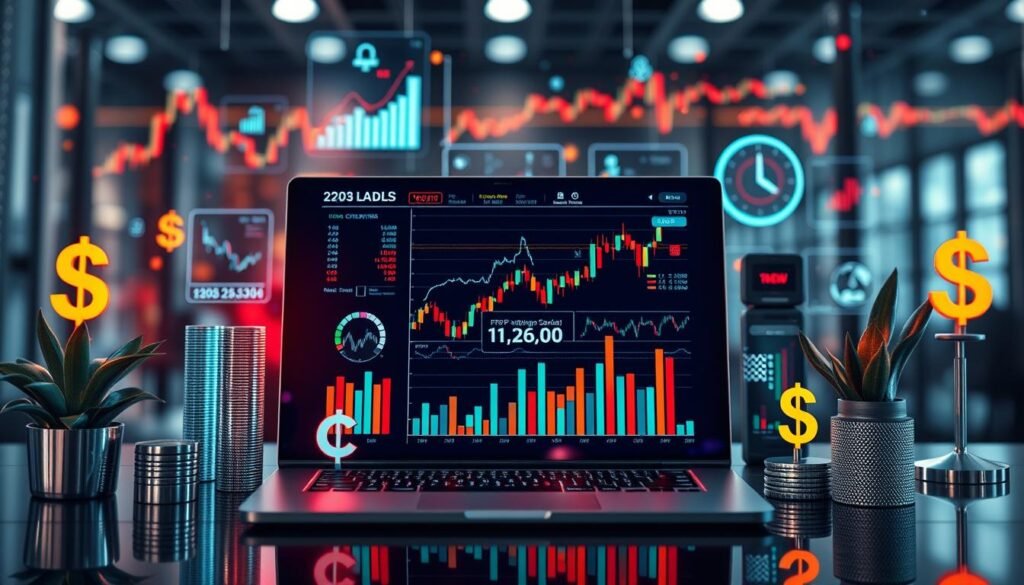
The Use of Financial Simulation in Trading Assessments
Financial simulation is key in evaluating potential traders. It lets prop trading firms test candidates in a safe, virtual market. This way, they can check if the traders can handle real market challenges without risking real money.
These simulations are crucial for making decisions. They give a real-like experience for testing different trading plans. This helps reduce risks and shows how well traders might do in real markets.
- Simulation models mirror complex market dynamics
- Evaluation based on diverse market scenarios
- Assessment of risk management capabilities
The data from these simulations is very useful. It helps firms create specific evaluation criteria. This is based on the firm’s needs and how much risk they can take. With detailed analysis, firms can pick the best candidates for real trading.
| Feature | Advantage |
|---|---|
| Controlled environment | Allows for safe testing of high-risk strategies |
| Diverse scenario adaptation | Prepares traders for unexpected market changes |
| Data generation | Provides robust analytics for better candidate evaluation |
In summary, financial simulation is vital for improving trading strategies and evaluating traders. It helps prop trading firms find skilled traders ready for the real market. This way, they can make the most of market changes.
Scalability of Trading Strategies from Simulated to Real Environments
Looking into the move from simulated trading accounts to real trading accounts shows us a lot about trading strategies. We see how strategies that work in a fake setting do in the real world. We also learn about the challenges traders face when they make this big change.
Transitioning from a Simulated to a Live Trading Environment
Going from fake accounts to real ones is a big step for traders. It’s a chance to see if their skills work in real market conditions. They need to adjust their risk management and decision-making to the real world to make money in the long run.
Challenges Traders Face in Different Account Types
Changing from fake to real accounts is tough. Traders feel a lot of pressure when they start using real money. It’s important to understand these feelings to manage trades well in real life.
| Aspect | Simulated Account | Real Account |
|---|---|---|
| Risk Perception | Low | High |
| Emotional Impact | Minimal | Significant |
| Strategy Testing | Endless scenarios without financial repercussion | Limited by financial constraints and market conditions |
| Outcome | Learning and strategy development | Actual profit or loss |
The table shows the main differences between fake and real settings. It highlights why traders need to adjust their strategies when moving to real trading.
How Trading Performance Assessment Differs by Account Type
In the world of proprietary trading, how you assess performance changes with the type of account. Whether it’s a simulated or real trading account, each has its own data. This data shapes the criteria used in evaluations.
Quantitative vs Qualitative Measures of Trading Success
Quantitative measures focus on numbers like profit margins and risk levels. These are key in real accounts where financial risk is real. On the other hand, qualitative measures look at a trader’s strategic thinking and adaptability. This is often seen in simulated environments where the pressure is different.
Feedback and Growth Opportunities in Prop Firm Evaluations
Feedback from prop trading firms is crucial for a trader’s growth. This feedback, whether from automated systems or senior traders, is customized. It’s based on the specific environment—simulated or real. This ensures traders understand their performance and the trading nuances beyond numbers.
| Evaluation Type | Key Focus Areas | Potential for Real-Time Feedback | Applicability of Results |
|---|---|---|---|
| Simulated Account | Risk Management, Strategy Testing | High (via simulations and retrospectives) | High in theory-focused environments |
| Real Account | Profitability, Consistency | Continuous (real-time market consequences) | Directly applicable to live market conditions |
Maximizing Success in Prop Trading Firm Evaluations
Success in proprietary trading firm evaluations depends on careful trading performance assessment and strict risk management in prop trading. A well-planned strategy is key to meeting a prop firm’s high standards. Here, we look at important strategies and practices to boost a trader’s success chances.
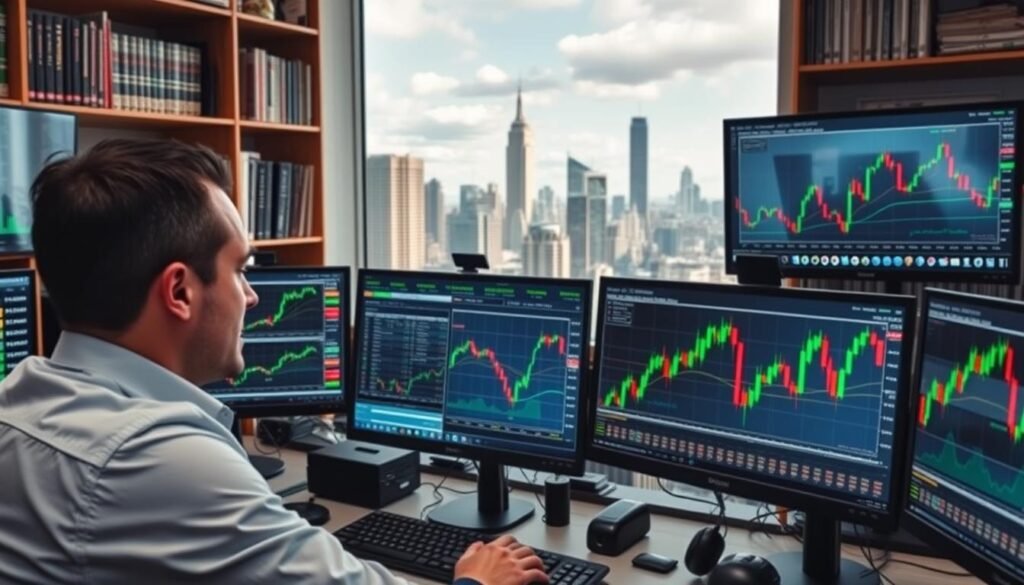
- Understand and Meet Evaluation Criteria
- Continuous Risk Management Calibration
- Use Feedback for Continuous Improvement
- Stay Updated with Market Trends and Dynamics
| Strategy | Benefits | Implementation |
|---|---|---|
| Comprehensive Trading Logs | Tracks progress and identifies patterns | Log all trades and review weekly |
| Solid Risk Management Framework | Minimizes losses and protects capital | Set stop-loss orders, analyze risk/reward ratios |
| Adaptation to Market Changes | Enhances adaptability and profitability | Regularly adjust strategies to market conditions |
| Feedback Utilization | Promotes growth and performance enhancement | Implement insights from evaluations into trading practice |
Using these strategies wisely helps traders not just pass evaluations but build a strong prop trading career. The ability to adapt and improve trading performance assessment and risk management based on feedback and market changes shows a trader’s commitment and skill. This is crucial in the competitive world of proprietary trading.
Preparing for Prop Trading Firm Evaluations: Practical Tips
To succeed in prop trading evaluations, you need a solid strategy. It should meet the prop trading evaluation criteria. This approach helps you perform well and get a spot in the competitive trading world.
Building Your Strategy around the Evaluation Criteria
Knowing what the evaluation focuses on is key. Prop trading firms look at strategy, risk management, and profit. A strategy that fits these criteria, tested in simulated accounts, boosts your readiness and performance.
Key Considerations When Practicing with Simulated Accounts
Simulated trading accounts let you practice without risk. It’s important to treat them like real trading. Here are tips for effective simulated trading:
- Make consistent trading decisions to mimic real trading.
- Keep detailed records of trades and strategies to track progress and areas for improvement.
- Use advanced tools in simulated platforms to understand market behaviors better.
Following these tips helps you develop a disciplined approach. It prepares you for the high standards of top prop trading firms and familiarizes you with the evaluation criteria.
| Feature | Simulated Account Practice | Real Account Application |
|---|---|---|
| Risk Management | Test various levels of risk without financial consequences | Strategize to balance profit goals with real-market risks |
| Strategy Testing | Unlimited trial and error opportunities for strategy perfection | Immediate real-world feedback on strategy effectiveness |
| Analytics Use | Access to comprehensive digital tools for market analysis | Application of analytical insights to tangible market conditions |
Mastering simulated trading environments prepares you for prop trading evaluations. It also sets you up for a successful trading career.
The Future of Prop Trading: Simulated and Real Account Mixture
In the fast-changing world of proprietary trading, a big trend is combining financial simulation with real market conditions. Prop trading firms are moving towards using both simulated and real trading accounts. This mix aims to use the controlled setting of simulations and the real-world challenges of live markets. It’s a way to fully test a trader’s skills.
New technologies are making financial simulation tools more realistic and useful. These tools help in training and evaluating traders at prop trading firms. By mixing these tools with real trading scenarios, firms can assess traders in a more detailed way. This approach helps develop both analytical skills and emotional strength, key for success in finance.
The way we judge a trader’s success is changing with this new mix of simulated and real trading. New methods and tools are expected to improve how firms pick and train traders. This shift is crucial for both new and experienced traders as they move between virtual training and the real financial world.
